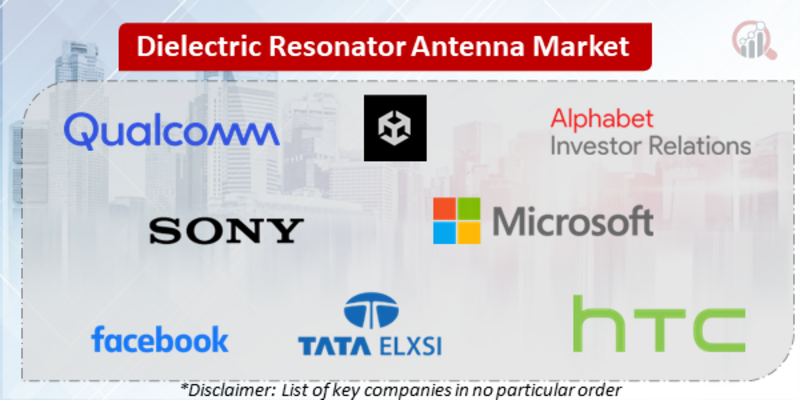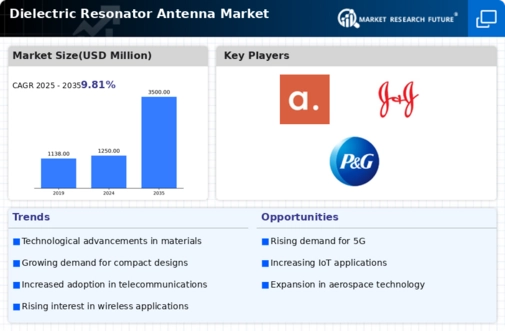Top Industry Leaders in the Dielectric Resonator Antenna Market

The Competitive Landscape of Dielectric Resonator Antenna Market
Across the bustling world of wireless communication, a silent symphony unfolds – dielectric resonator antennas (DRAs) hum with precise energy, whispering data and signals through ceramic whispers. This dynamic market pulses with the competitive rhythm of players orchestrating this high-precision performance. Understanding their strategies, the factors influencing market share, and the overall competitive scenario is crucial for navigating this complex terrain.
Key Players:
- Accenture plc
- Qualcomm Incorporated
- Unity Technologies
- Adobe Inc.
- Alphabet Inc.
- SoftServe Inc.
- Northern Digital Inc.
- Sony Corporation
- Facebook Inc.
- Microsoft Corporation
- Tata Elxsi
- Semcon
- HTC Corporation
Strategies Adopted by Leaders:
- Technological Prowess: Kyocera and Murata Manufacturing lead the charge with expertise in high-performance DRAs for diverse applications, offering superior frequency stability, efficiency, and compact designs, catering to demanding needs in satellite communications, radar systems, and base stations.
- Vertical Specialization: TDK Electronics focuses on cost-effective DRAs for consumer electronics like wearable devices and smartphones, while Johanson Technology targets niche applications like medical implants and IoT sensors.
- Partnership Play: NXP Semiconductors collaborates with antenna designers and system integrators, offering customized DRA solutions and seamless integration with radio frequency (RF) components.
- Focus on Miniaturization and Performance Enhancement: Utilizing advanced ceramics and design techniques, companies develop smaller, lighter DRAs with high gain, wide bandwidths, and sharp directivity, commanding premium prices and securing market share in space-constrained applications.
- Embrace of Additive Manufacturing and Sustainable Materials: Implementing 3D printing technologies and environmentally friendly ceramics reduces waste, enables complex antenna designs, and resonates with sustainability-conscious customers.
Factors for Market Share Analysis:
- Antenna Performance and Efficiency: Companies offering DRAs with superior gain, radiation patterns, and low loss factors command premium prices and secure market share by enabling reliable signals, extended communication ranges, and efficient power utilization.
- Cost Competitiveness and Affordability: Balancing advanced functionalities with an attractive price point is crucial for capturing market share, particularly in price-sensitive segments like consumer electronics and emerging markets.
- Compactness and Integration: Developing small, lightweight DRAs that seamlessly integrate into existing system designs is crucial for space-constrained applications like mobile devices and wearables.
- Frequency Range and Versatility: Offering DRAs that operate across diverse frequency bands and support multiple wireless standards broadens market reach and opens doors to diverse applications.
- Environmental Ruggedness and Reliability: DRAs must withstand harsh operating conditions like extreme temperatures, vibrations, and moisture. High reliability and minimal maintenance needs attract users and secure market share.
New and Emerging Companies:
- Startups like Ethertronics and Anokiwave: These innovators focus on developing next-generation DRAs using metamaterials and advanced fabrication techniques, aiming to revolutionize antenna performance and miniaturization for cutting-edge applications.
- Academia and Research Labs: MIT's Antenna and RF Circuits Laboratory and Georgia Institute of Technology's Electromagnetics Laboratory explore disruptive technologies like reconfigurable DRAs and software-defined antennas, shaping the future of the market.
- Advanced Simulation and Design Tools: Companies like Ansys and Keysight Technologies develop software platforms for optimizing DRA design, predicting performance, and accelerating innovation, reducing development costs and time-to-market.
Industry Developments:
Sony Corporation:
- Sony Electronics uses DRAs in some of their wireless communication products, like Wi-Fi routers and Bluetooth speakers, for their compact size and high efficiency.
- Sony Semiconductor Solutions offers integrated modules combining DRAs with RF circuits for various applications, including automotive radar and IoT devices.
- Sony Research Laboratories are exploring the use of DRAs in metamaterial-based antennas for next-generation wireless communication systems.
Facebook Inc.:
- Facebook Connectivity focuses on improving internet access in underserved areas, and DRAs could potentially play a role in providing affordable and reliable wireless connectivity solutions.
- Facebook Reality Labs, working on VR and AR technologies, might utilize DRAs in future headset designs for improved antenna performance and miniaturization.
- Facebook AI Research is exploring the use of DRAs in cognitive radio systems that can adapt their operating parameters based on the surrounding environment.
Microsoft Corporation:
- Microsoft Azure IoT services could potentially leverage DRAs in IoT devices for their low power consumption and compact size.
- Microsoft HoloLens mixed reality headset may benefit from future use of DRAs for improved antenna performance and integration within the device.
- Microsoft Research is exploring the use of DRAs in metamaterial-based antennas for enhanced wireless communication speeds and efficiency.
